BSc Computer Science Project: Developing an Internet Quiz System
VerifiedAdded on 2023/04/21
|15
|4167
|95
Project
AI Summary
This dissertation presents a Bachelor of Science in Computer Science project focused on the development of an internet quiz system. The project's primary objective is to create an interactive web application designed to assist in education, particularly for primary school mathematics. The system is designed to generate quizzes with arithmetic and algebra questions. The project's key outcomes include a web application capable of randomly selecting questions, a MySQL database for storing quiz results, and the use of Java and JavaScript for question selection, along with HTML and CSS for the application's front-end. The dissertation details the project's literature review, design, implementation, and testing phases, culminating in an evaluation and conclusion. The literature review explores the role of ICT in education, discussing the use of computers and the internet in educational settings, and the impact of technology on learning. The system aims to provide an effective tool for students to practice and assess their understanding of mathematical concepts, offering a valuable resource for both students and educators in the digital age.
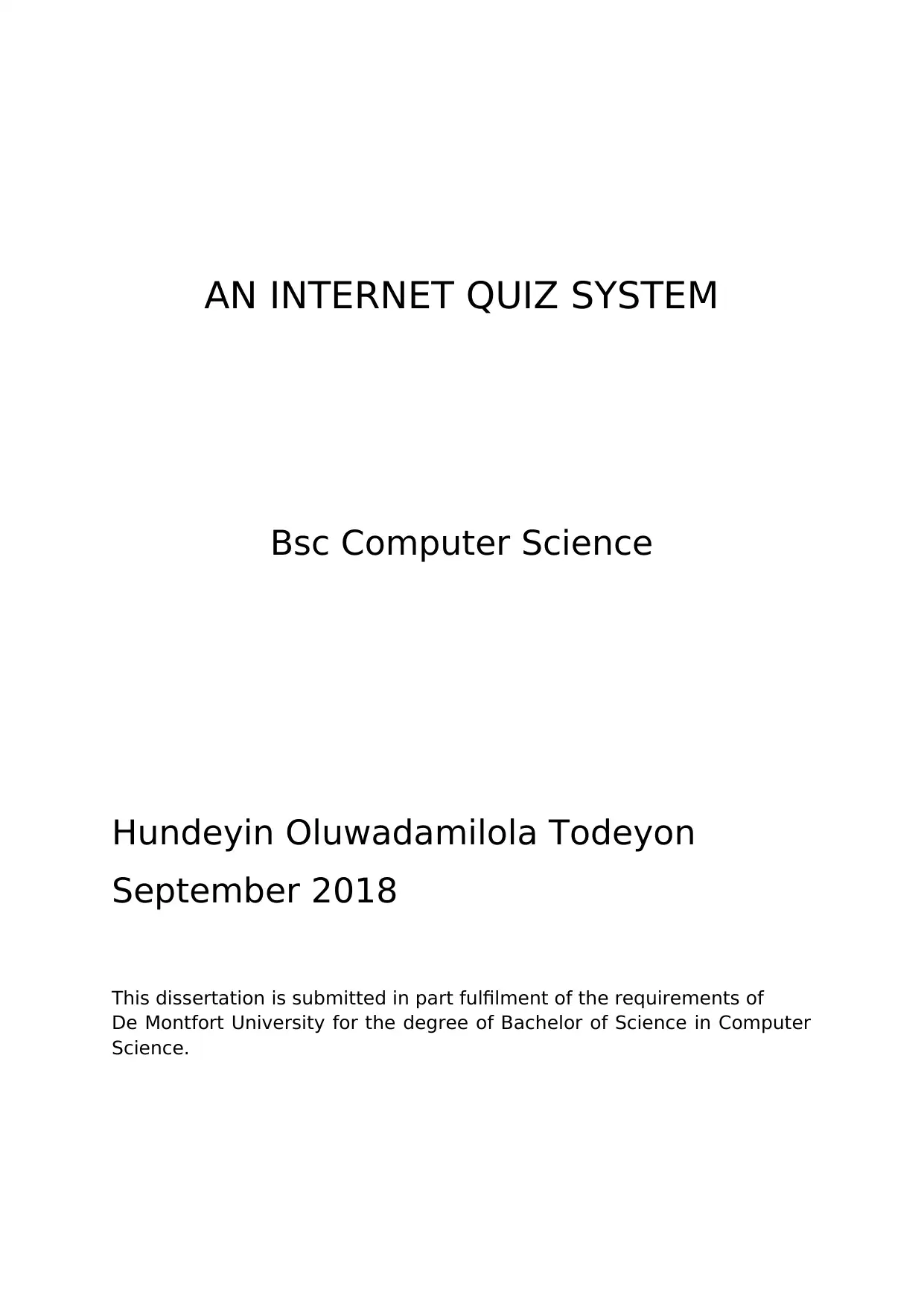
AN INTERNET QUIZ SYSTEM
Bsc Computer Science
Hundeyin Oluwadamilola Todeyon
September 2018
This dissertation is submitted in part fulfilment of the requirements of
De Montfort University for the degree of Bachelor of Science in Computer
Science.
Bsc Computer Science
Hundeyin Oluwadamilola Todeyon
September 2018
This dissertation is submitted in part fulfilment of the requirements of
De Montfort University for the degree of Bachelor of Science in Computer
Science.
Paraphrase This Document
Need a fresh take? Get an instant paraphrase of this document with our AI Paraphraser

ABSTRACT

ACKNOWLEDGMENTS
⊘ This is a preview!⊘
Do you want full access?
Subscribe today to unlock all pages.

Trusted by 1+ million students worldwide
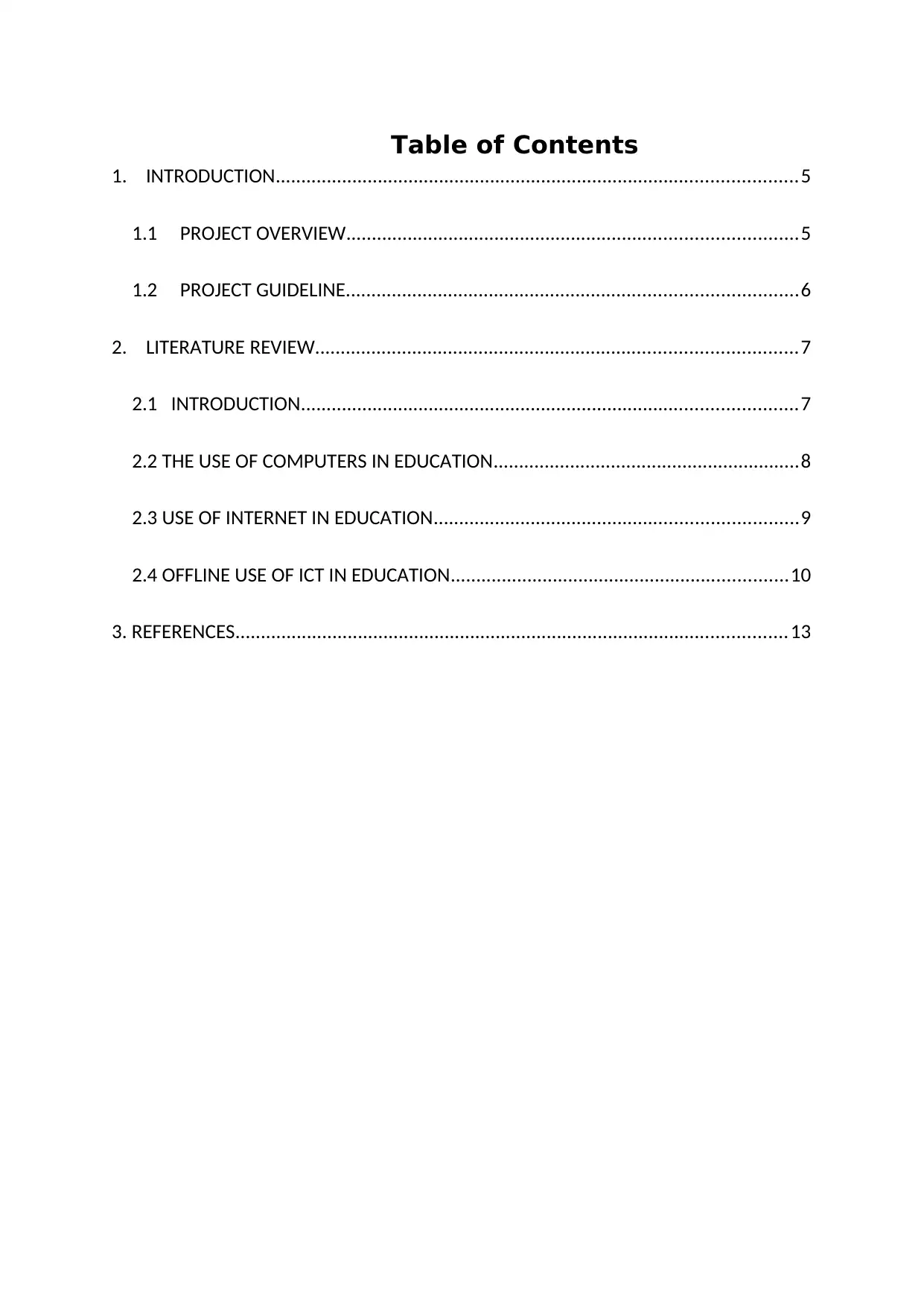
Table of Contents
1. INTRODUCTION......................................................................................................5
1.1 PROJECT OVERVIEW........................................................................................5
1.2 PROJECT GUIDELINE........................................................................................6
2. LITERATURE REVIEW..............................................................................................7
2.1 INTRODUCTION.................................................................................................7
2.2 THE USE OF COMPUTERS IN EDUCATION............................................................8
2.3 USE OF INTERNET IN EDUCATION.......................................................................9
2.4 OFFLINE USE OF ICT IN EDUCATION..................................................................10
3. REFERENCES............................................................................................................13
1. INTRODUCTION......................................................................................................5
1.1 PROJECT OVERVIEW........................................................................................5
1.2 PROJECT GUIDELINE........................................................................................6
2. LITERATURE REVIEW..............................................................................................7
2.1 INTRODUCTION.................................................................................................7
2.2 THE USE OF COMPUTERS IN EDUCATION............................................................8
2.3 USE OF INTERNET IN EDUCATION.......................................................................9
2.4 OFFLINE USE OF ICT IN EDUCATION..................................................................10
3. REFERENCES............................................................................................................13
Paraphrase This Document
Need a fresh take? Get an instant paraphrase of this document with our AI Paraphraser
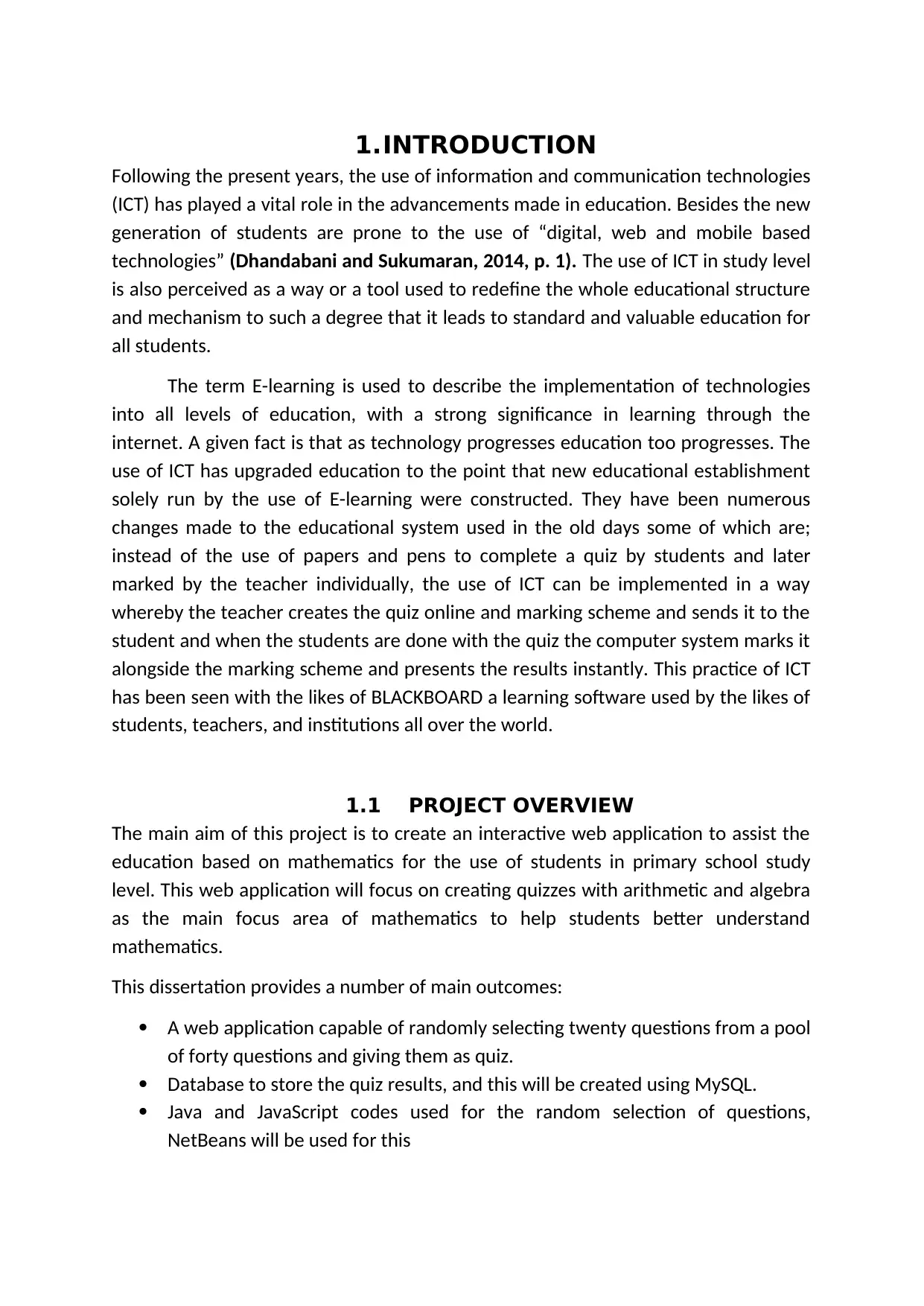
1.INTRODUCTION
Following the present years, the use of information and communication technologies
(ICT) has played a vital role in the advancements made in education. Besides the new
generation of students are prone to the use of “digital, web and mobile based
technologies” (Dhandabani and Sukumaran, 2014, p. 1). The use of ICT in study level
is also perceived as a way or a tool used to redefine the whole educational structure
and mechanism to such a degree that it leads to standard and valuable education for
all students.
The term E-learning is used to describe the implementation of technologies
into all levels of education, with a strong significance in learning through the
internet. A given fact is that as technology progresses education too progresses. The
use of ICT has upgraded education to the point that new educational establishment
solely run by the use of E-learning were constructed. They have been numerous
changes made to the educational system used in the old days some of which are;
instead of the use of papers and pens to complete a quiz by students and later
marked by the teacher individually, the use of ICT can be implemented in a way
whereby the teacher creates the quiz online and marking scheme and sends it to the
student and when the students are done with the quiz the computer system marks it
alongside the marking scheme and presents the results instantly. This practice of ICT
has been seen with the likes of BLACKBOARD a learning software used by the likes of
students, teachers, and institutions all over the world.
1.1 PROJECT OVERVIEW
The main aim of this project is to create an interactive web application to assist the
education based on mathematics for the use of students in primary school study
level. This web application will focus on creating quizzes with arithmetic and algebra
as the main focus area of mathematics to help students better understand
mathematics.
This dissertation provides a number of main outcomes:
A web application capable of randomly selecting twenty questions from a pool
of forty questions and giving them as quiz.
Database to store the quiz results, and this will be created using MySQL.
Java and JavaScript codes used for the random selection of questions,
NetBeans will be used for this
Following the present years, the use of information and communication technologies
(ICT) has played a vital role in the advancements made in education. Besides the new
generation of students are prone to the use of “digital, web and mobile based
technologies” (Dhandabani and Sukumaran, 2014, p. 1). The use of ICT in study level
is also perceived as a way or a tool used to redefine the whole educational structure
and mechanism to such a degree that it leads to standard and valuable education for
all students.
The term E-learning is used to describe the implementation of technologies
into all levels of education, with a strong significance in learning through the
internet. A given fact is that as technology progresses education too progresses. The
use of ICT has upgraded education to the point that new educational establishment
solely run by the use of E-learning were constructed. They have been numerous
changes made to the educational system used in the old days some of which are;
instead of the use of papers and pens to complete a quiz by students and later
marked by the teacher individually, the use of ICT can be implemented in a way
whereby the teacher creates the quiz online and marking scheme and sends it to the
student and when the students are done with the quiz the computer system marks it
alongside the marking scheme and presents the results instantly. This practice of ICT
has been seen with the likes of BLACKBOARD a learning software used by the likes of
students, teachers, and institutions all over the world.
1.1 PROJECT OVERVIEW
The main aim of this project is to create an interactive web application to assist the
education based on mathematics for the use of students in primary school study
level. This web application will focus on creating quizzes with arithmetic and algebra
as the main focus area of mathematics to help students better understand
mathematics.
This dissertation provides a number of main outcomes:
A web application capable of randomly selecting twenty questions from a pool
of forty questions and giving them as quiz.
Database to store the quiz results, and this will be created using MySQL.
Java and JavaScript codes used for the random selection of questions,
NetBeans will be used for this
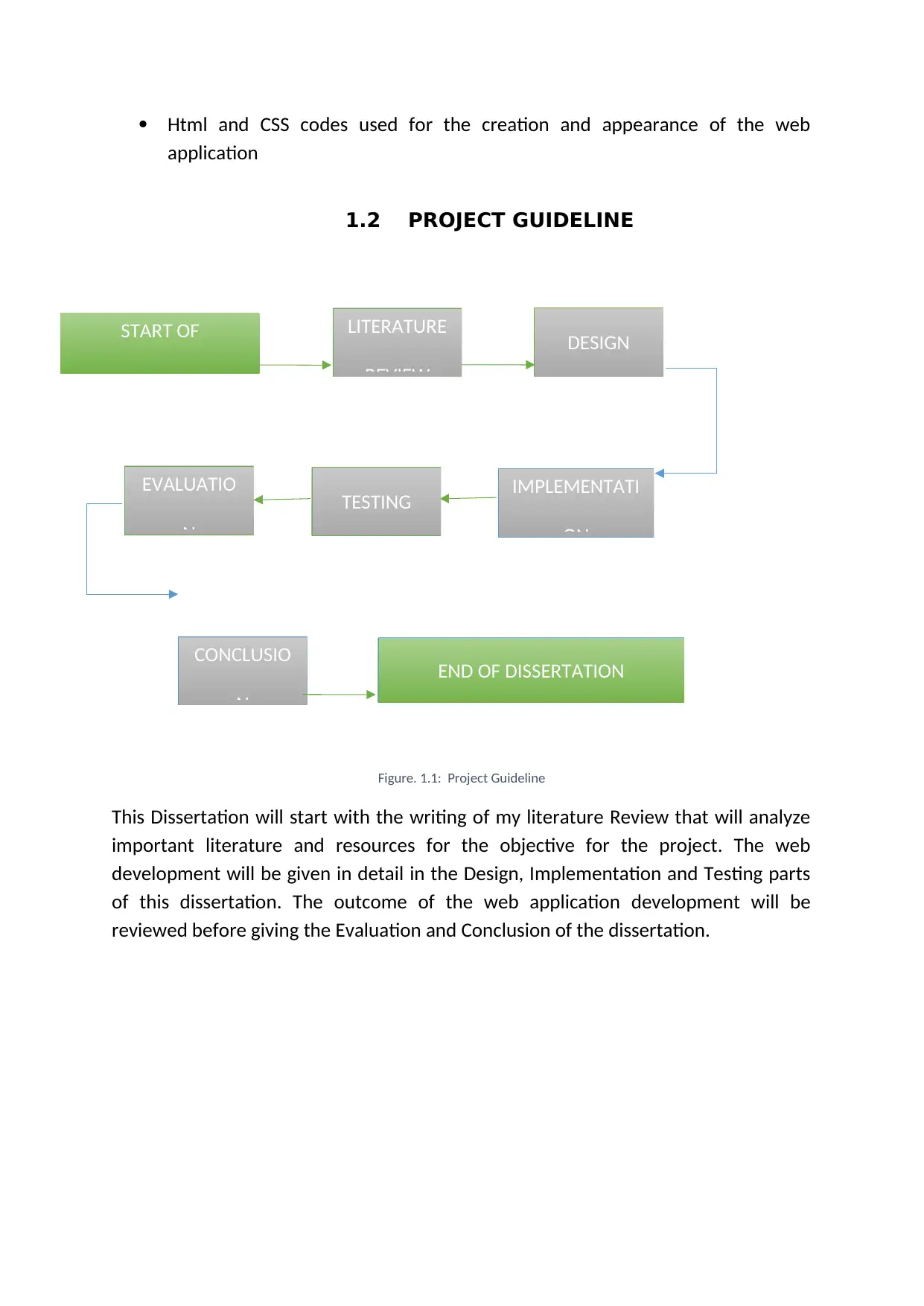
Html and CSS codes used for the creation and appearance of the web
application
1.2 PROJECT GUIDELINE
Figure. 1.1: Project Guideline
This Dissertation will start with the writing of my literature Review that will analyze
important literature and resources for the objective for the project. The web
development will be given in detail in the Design, Implementation and Testing parts
of this dissertation. The outcome of the web application development will be
reviewed before giving the Evaluation and Conclusion of the dissertation.
START OF
DISSERTATION
LITERATURE
REVIEW
DESIGN
IMPLEMENTATI
ON
TESTING
EVALUATIO
N
END OF DISSERTATION
CONCLUSIO
N
application
1.2 PROJECT GUIDELINE
Figure. 1.1: Project Guideline
This Dissertation will start with the writing of my literature Review that will analyze
important literature and resources for the objective for the project. The web
development will be given in detail in the Design, Implementation and Testing parts
of this dissertation. The outcome of the web application development will be
reviewed before giving the Evaluation and Conclusion of the dissertation.
START OF
DISSERTATION
LITERATURE
REVIEW
DESIGN
IMPLEMENTATI
ON
TESTING
EVALUATIO
N
END OF DISSERTATION
CONCLUSIO
N
⊘ This is a preview!⊘
Do you want full access?
Subscribe today to unlock all pages.

Trusted by 1+ million students worldwide
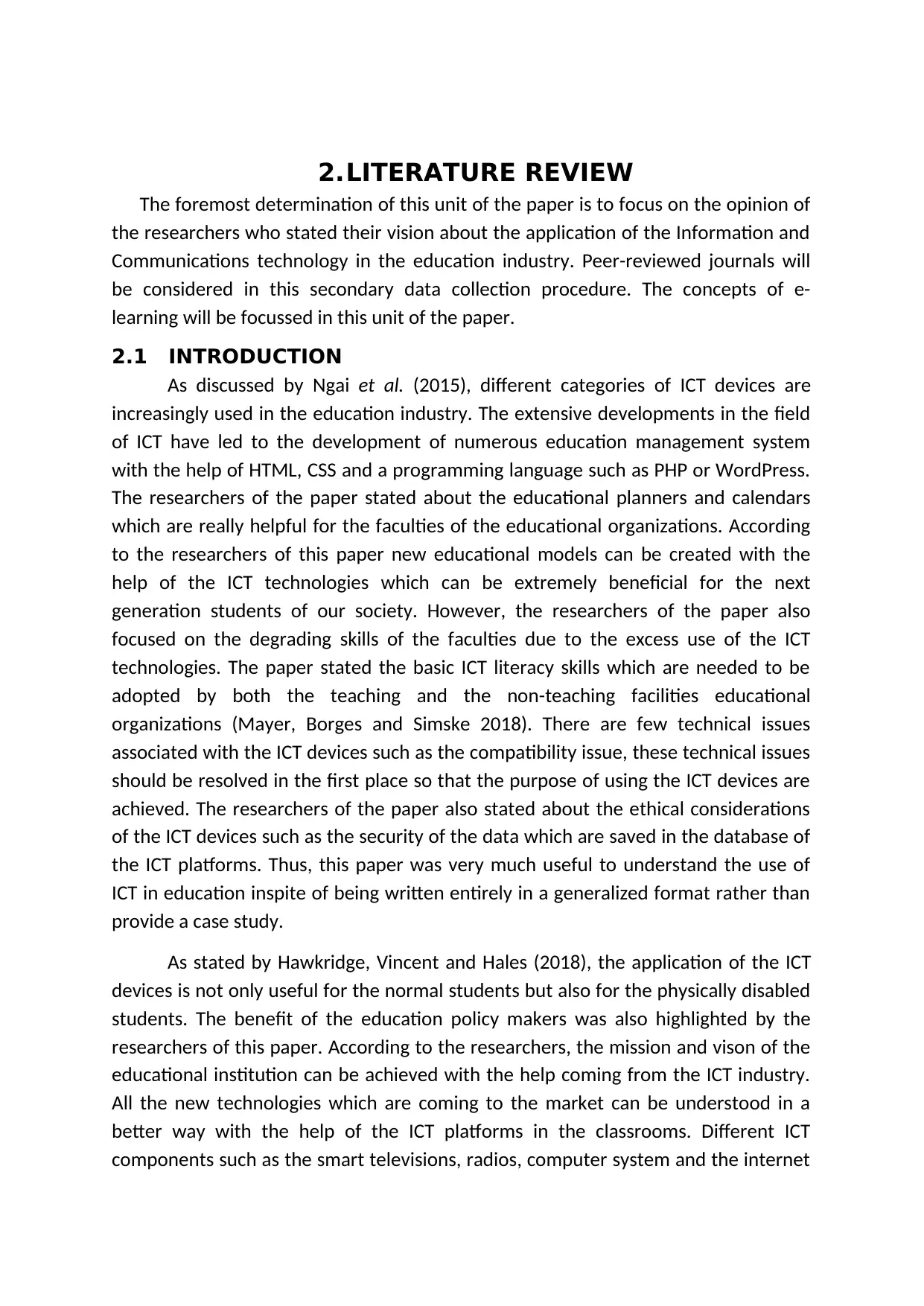
2.LITERATURE REVIEW
The foremost determination of this unit of the paper is to focus on the opinion of
the researchers who stated their vision about the application of the Information and
Communications technology in the education industry. Peer-reviewed journals will
be considered in this secondary data collection procedure. The concepts of e-
learning will be focussed in this unit of the paper.
2.1 INTRODUCTION
As discussed by Ngai et al. (2015), different categories of ICT devices are
increasingly used in the education industry. The extensive developments in the field
of ICT have led to the development of numerous education management system
with the help of HTML, CSS and a programming language such as PHP or WordPress.
The researchers of the paper stated about the educational planners and calendars
which are really helpful for the faculties of the educational organizations. According
to the researchers of this paper new educational models can be created with the
help of the ICT technologies which can be extremely beneficial for the next
generation students of our society. However, the researchers of the paper also
focused on the degrading skills of the faculties due to the excess use of the ICT
technologies. The paper stated the basic ICT literacy skills which are needed to be
adopted by both the teaching and the non-teaching facilities educational
organizations (Mayer, Borges and Simske 2018). There are few technical issues
associated with the ICT devices such as the compatibility issue, these technical issues
should be resolved in the first place so that the purpose of using the ICT devices are
achieved. The researchers of the paper also stated about the ethical considerations
of the ICT devices such as the security of the data which are saved in the database of
the ICT platforms. Thus, this paper was very much useful to understand the use of
ICT in education inspite of being written entirely in a generalized format rather than
provide a case study.
As stated by Hawkridge, Vincent and Hales (2018), the application of the ICT
devices is not only useful for the normal students but also for the physically disabled
students. The benefit of the education policy makers was also highlighted by the
researchers of this paper. According to the researchers, the mission and vison of the
educational institution can be achieved with the help coming from the ICT industry.
All the new technologies which are coming to the market can be understood in a
better way with the help of the ICT platforms in the classrooms. Different ICT
components such as the smart televisions, radios, computer system and the internet
The foremost determination of this unit of the paper is to focus on the opinion of
the researchers who stated their vision about the application of the Information and
Communications technology in the education industry. Peer-reviewed journals will
be considered in this secondary data collection procedure. The concepts of e-
learning will be focussed in this unit of the paper.
2.1 INTRODUCTION
As discussed by Ngai et al. (2015), different categories of ICT devices are
increasingly used in the education industry. The extensive developments in the field
of ICT have led to the development of numerous education management system
with the help of HTML, CSS and a programming language such as PHP or WordPress.
The researchers of the paper stated about the educational planners and calendars
which are really helpful for the faculties of the educational organizations. According
to the researchers of this paper new educational models can be created with the
help of the ICT technologies which can be extremely beneficial for the next
generation students of our society. However, the researchers of the paper also
focused on the degrading skills of the faculties due to the excess use of the ICT
technologies. The paper stated the basic ICT literacy skills which are needed to be
adopted by both the teaching and the non-teaching facilities educational
organizations (Mayer, Borges and Simske 2018). There are few technical issues
associated with the ICT devices such as the compatibility issue, these technical issues
should be resolved in the first place so that the purpose of using the ICT devices are
achieved. The researchers of the paper also stated about the ethical considerations
of the ICT devices such as the security of the data which are saved in the database of
the ICT platforms. Thus, this paper was very much useful to understand the use of
ICT in education inspite of being written entirely in a generalized format rather than
provide a case study.
As stated by Hawkridge, Vincent and Hales (2018), the application of the ICT
devices is not only useful for the normal students but also for the physically disabled
students. The benefit of the education policy makers was also highlighted by the
researchers of this paper. According to the researchers, the mission and vison of the
educational institution can be achieved with the help coming from the ICT industry.
All the new technologies which are coming to the market can be understood in a
better way with the help of the ICT platforms in the classrooms. Different ICT
components such as the smart televisions, radios, computer system and the internet
Paraphrase This Document
Need a fresh take? Get an instant paraphrase of this document with our AI Paraphraser
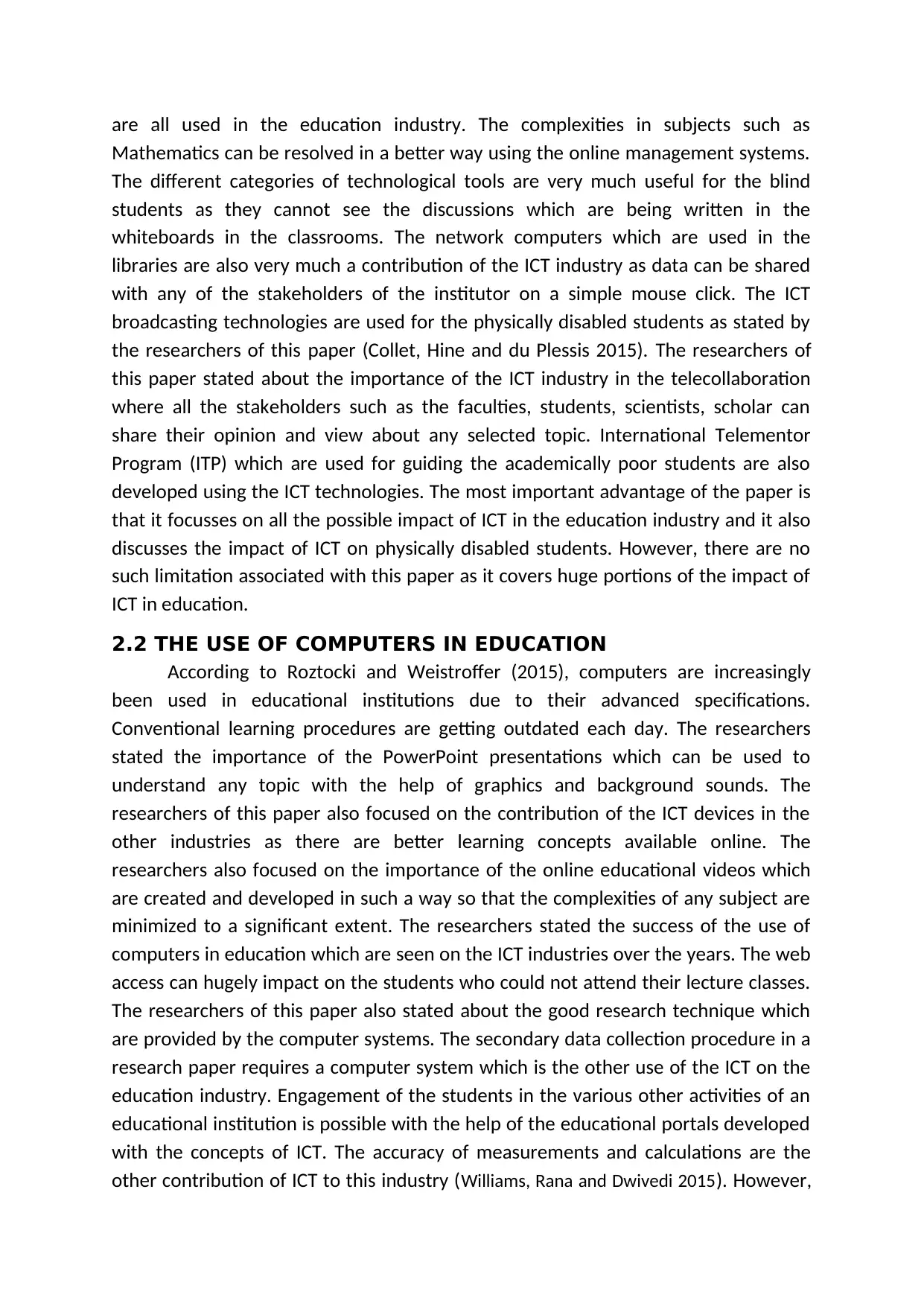
are all used in the education industry. The complexities in subjects such as
Mathematics can be resolved in a better way using the online management systems.
The different categories of technological tools are very much useful for the blind
students as they cannot see the discussions which are being written in the
whiteboards in the classrooms. The network computers which are used in the
libraries are also very much a contribution of the ICT industry as data can be shared
with any of the stakeholders of the institutor on a simple mouse click. The ICT
broadcasting technologies are used for the physically disabled students as stated by
the researchers of this paper (Collet, Hine and du Plessis 2015). The researchers of
this paper stated about the importance of the ICT industry in the telecollaboration
where all the stakeholders such as the faculties, students, scientists, scholar can
share their opinion and view about any selected topic. International Telementor
Program (ITP) which are used for guiding the academically poor students are also
developed using the ICT technologies. The most important advantage of the paper is
that it focusses on all the possible impact of ICT in the education industry and it also
discusses the impact of ICT on physically disabled students. However, there are no
such limitation associated with this paper as it covers huge portions of the impact of
ICT in education.
2.2 THE USE OF COMPUTERS IN EDUCATION
According to Roztocki and Weistroffer (2015), computers are increasingly
been used in educational institutions due to their advanced specifications.
Conventional learning procedures are getting outdated each day. The researchers
stated the importance of the PowerPoint presentations which can be used to
understand any topic with the help of graphics and background sounds. The
researchers of this paper also focused on the contribution of the ICT devices in the
other industries as there are better learning concepts available online. The
researchers also focused on the importance of the online educational videos which
are created and developed in such a way so that the complexities of any subject are
minimized to a significant extent. The researchers stated the success of the use of
computers in education which are seen on the ICT industries over the years. The web
access can hugely impact on the students who could not attend their lecture classes.
The researchers of this paper also stated about the good research technique which
are provided by the computer systems. The secondary data collection procedure in a
research paper requires a computer system which is the other use of the ICT on the
education industry. Engagement of the students in the various other activities of an
educational institution is possible with the help of the educational portals developed
with the concepts of ICT. The accuracy of measurements and calculations are the
other contribution of ICT to this industry (Williams, Rana and Dwivedi 2015). However,
Mathematics can be resolved in a better way using the online management systems.
The different categories of technological tools are very much useful for the blind
students as they cannot see the discussions which are being written in the
whiteboards in the classrooms. The network computers which are used in the
libraries are also very much a contribution of the ICT industry as data can be shared
with any of the stakeholders of the institutor on a simple mouse click. The ICT
broadcasting technologies are used for the physically disabled students as stated by
the researchers of this paper (Collet, Hine and du Plessis 2015). The researchers of
this paper stated about the importance of the ICT industry in the telecollaboration
where all the stakeholders such as the faculties, students, scientists, scholar can
share their opinion and view about any selected topic. International Telementor
Program (ITP) which are used for guiding the academically poor students are also
developed using the ICT technologies. The most important advantage of the paper is
that it focusses on all the possible impact of ICT in the education industry and it also
discusses the impact of ICT on physically disabled students. However, there are no
such limitation associated with this paper as it covers huge portions of the impact of
ICT in education.
2.2 THE USE OF COMPUTERS IN EDUCATION
According to Roztocki and Weistroffer (2015), computers are increasingly
been used in educational institutions due to their advanced specifications.
Conventional learning procedures are getting outdated each day. The researchers
stated the importance of the PowerPoint presentations which can be used to
understand any topic with the help of graphics and background sounds. The
researchers of this paper also focused on the contribution of the ICT devices in the
other industries as there are better learning concepts available online. The
researchers also focused on the importance of the online educational videos which
are created and developed in such a way so that the complexities of any subject are
minimized to a significant extent. The researchers stated the success of the use of
computers in education which are seen on the ICT industries over the years. The web
access can hugely impact on the students who could not attend their lecture classes.
The researchers of this paper also stated about the good research technique which
are provided by the computer systems. The secondary data collection procedure in a
research paper requires a computer system which is the other use of the ICT on the
education industry. Engagement of the students in the various other activities of an
educational institution is possible with the help of the educational portals developed
with the concepts of ICT. The accuracy of measurements and calculations are the
other contribution of ICT to this industry (Williams, Rana and Dwivedi 2015). However,
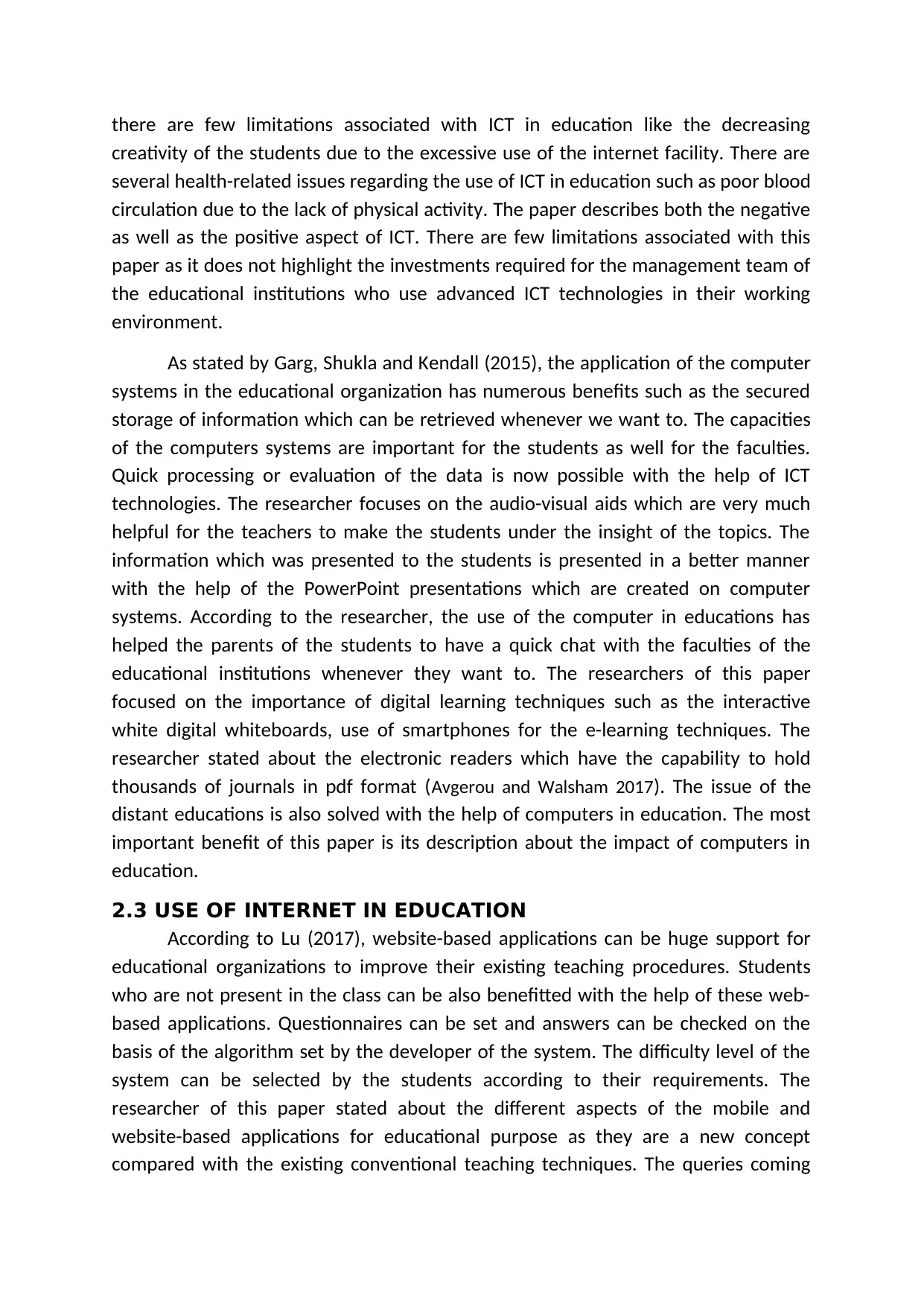
there are few limitations associated with ICT in education like the decreasing
creativity of the students due to the excessive use of the internet facility. There are
several health-related issues regarding the use of ICT in education such as poor blood
circulation due to the lack of physical activity. The paper describes both the negative
as well as the positive aspect of ICT. There are few limitations associated with this
paper as it does not highlight the investments required for the management team of
the educational institutions who use advanced ICT technologies in their working
environment.
As stated by Garg, Shukla and Kendall (2015), the application of the computer
systems in the educational organization has numerous benefits such as the secured
storage of information which can be retrieved whenever we want to. The capacities
of the computers systems are important for the students as well for the faculties.
Quick processing or evaluation of the data is now possible with the help of ICT
technologies. The researcher focuses on the audio-visual aids which are very much
helpful for the teachers to make the students under the insight of the topics. The
information which was presented to the students is presented in a better manner
with the help of the PowerPoint presentations which are created on computer
systems. According to the researcher, the use of the computer in educations has
helped the parents of the students to have a quick chat with the faculties of the
educational institutions whenever they want to. The researchers of this paper
focused on the importance of digital learning techniques such as the interactive
white digital whiteboards, use of smartphones for the e-learning techniques. The
researcher stated about the electronic readers which have the capability to hold
thousands of journals in pdf format (Avgerou and Walsham 2017). The issue of the
distant educations is also solved with the help of computers in education. The most
important benefit of this paper is its description about the impact of computers in
education.
2.3 USE OF INTERNET IN EDUCATION
According to Lu (2017), website-based applications can be huge support for
educational organizations to improve their existing teaching procedures. Students
who are not present in the class can be also benefitted with the help of these web-
based applications. Questionnaires can be set and answers can be checked on the
basis of the algorithm set by the developer of the system. The difficulty level of the
system can be selected by the students according to their requirements. The
researcher of this paper stated about the different aspects of the mobile and
website-based applications for educational purpose as they are a new concept
compared with the existing conventional teaching techniques. The queries coming
creativity of the students due to the excessive use of the internet facility. There are
several health-related issues regarding the use of ICT in education such as poor blood
circulation due to the lack of physical activity. The paper describes both the negative
as well as the positive aspect of ICT. There are few limitations associated with this
paper as it does not highlight the investments required for the management team of
the educational institutions who use advanced ICT technologies in their working
environment.
As stated by Garg, Shukla and Kendall (2015), the application of the computer
systems in the educational organization has numerous benefits such as the secured
storage of information which can be retrieved whenever we want to. The capacities
of the computers systems are important for the students as well for the faculties.
Quick processing or evaluation of the data is now possible with the help of ICT
technologies. The researcher focuses on the audio-visual aids which are very much
helpful for the teachers to make the students under the insight of the topics. The
information which was presented to the students is presented in a better manner
with the help of the PowerPoint presentations which are created on computer
systems. According to the researcher, the use of the computer in educations has
helped the parents of the students to have a quick chat with the faculties of the
educational institutions whenever they want to. The researchers of this paper
focused on the importance of digital learning techniques such as the interactive
white digital whiteboards, use of smartphones for the e-learning techniques. The
researcher stated about the electronic readers which have the capability to hold
thousands of journals in pdf format (Avgerou and Walsham 2017). The issue of the
distant educations is also solved with the help of computers in education. The most
important benefit of this paper is its description about the impact of computers in
education.
2.3 USE OF INTERNET IN EDUCATION
According to Lu (2017), website-based applications can be huge support for
educational organizations to improve their existing teaching procedures. Students
who are not present in the class can be also benefitted with the help of these web-
based applications. Questionnaires can be set and answers can be checked on the
basis of the algorithm set by the developer of the system. The difficulty level of the
system can be selected by the students according to their requirements. The
researcher of this paper stated about the different aspects of the mobile and
website-based applications for educational purpose as they are a new concept
compared with the existing conventional teaching techniques. The queries coming
⊘ This is a preview!⊘
Do you want full access?
Subscribe today to unlock all pages.

Trusted by 1+ million students worldwide
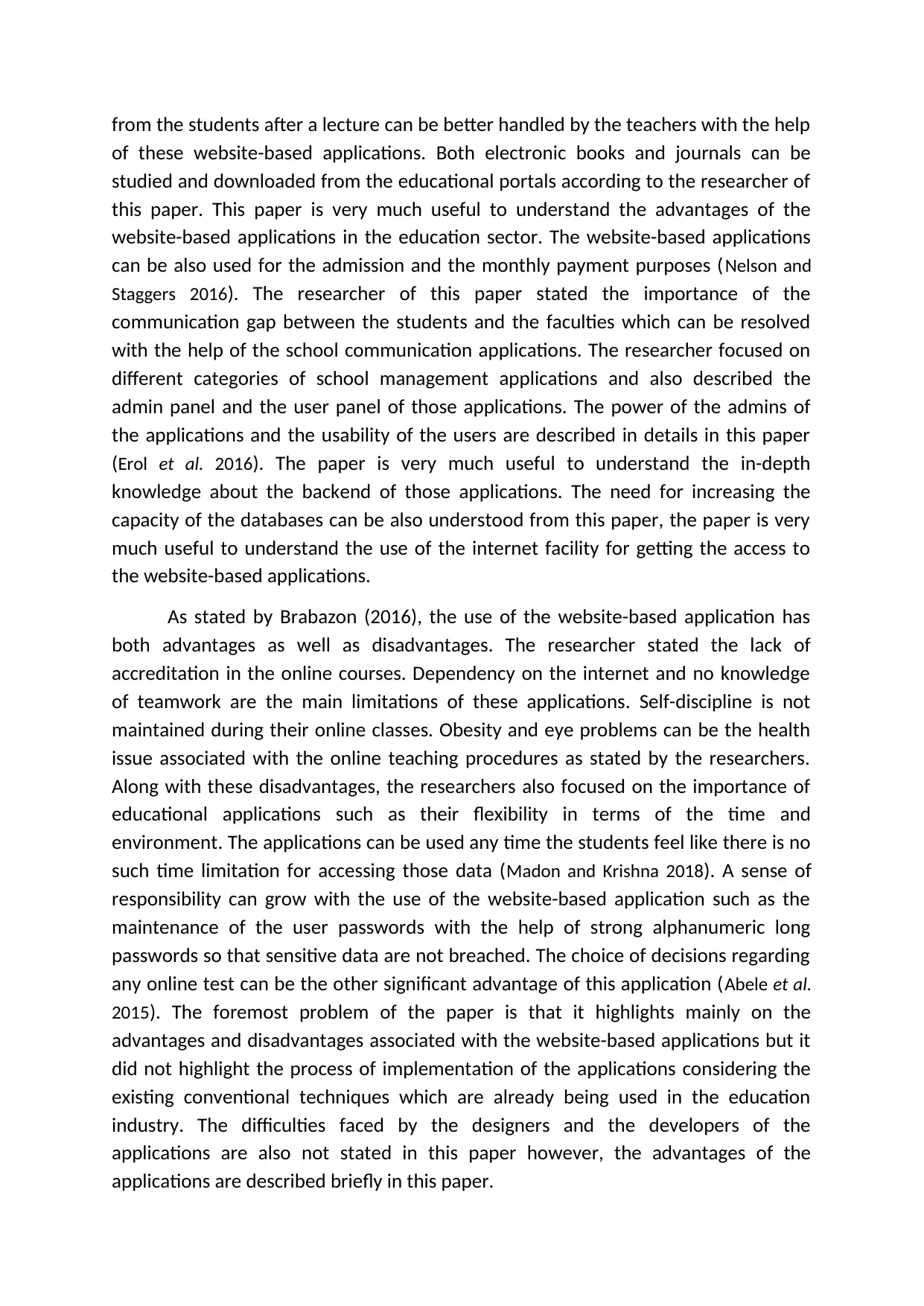
from the students after a lecture can be better handled by the teachers with the help
of these website-based applications. Both electronic books and journals can be
studied and downloaded from the educational portals according to the researcher of
this paper. This paper is very much useful to understand the advantages of the
website-based applications in the education sector. The website-based applications
can be also used for the admission and the monthly payment purposes (Nelson and
Staggers 2016). The researcher of this paper stated the importance of the
communication gap between the students and the faculties which can be resolved
with the help of the school communication applications. The researcher focused on
different categories of school management applications and also described the
admin panel and the user panel of those applications. The power of the admins of
the applications and the usability of the users are described in details in this paper
(Erol et al. 2016). The paper is very much useful to understand the in-depth
knowledge about the backend of those applications. The need for increasing the
capacity of the databases can be also understood from this paper, the paper is very
much useful to understand the use of the internet facility for getting the access to
the website-based applications.
As stated by Brabazon (2016), the use of the website-based application has
both advantages as well as disadvantages. The researcher stated the lack of
accreditation in the online courses. Dependency on the internet and no knowledge
of teamwork are the main limitations of these applications. Self-discipline is not
maintained during their online classes. Obesity and eye problems can be the health
issue associated with the online teaching procedures as stated by the researchers.
Along with these disadvantages, the researchers also focused on the importance of
educational applications such as their flexibility in terms of the time and
environment. The applications can be used any time the students feel like there is no
such time limitation for accessing those data (Madon and Krishna 2018). A sense of
responsibility can grow with the use of the website-based application such as the
maintenance of the user passwords with the help of strong alphanumeric long
passwords so that sensitive data are not breached. The choice of decisions regarding
any online test can be the other significant advantage of this application (Abele et al.
2015). The foremost problem of the paper is that it highlights mainly on the
advantages and disadvantages associated with the website-based applications but it
did not highlight the process of implementation of the applications considering the
existing conventional techniques which are already being used in the education
industry. The difficulties faced by the designers and the developers of the
applications are also not stated in this paper however, the advantages of the
applications are described briefly in this paper.
of these website-based applications. Both electronic books and journals can be
studied and downloaded from the educational portals according to the researcher of
this paper. This paper is very much useful to understand the advantages of the
website-based applications in the education sector. The website-based applications
can be also used for the admission and the monthly payment purposes (Nelson and
Staggers 2016). The researcher of this paper stated the importance of the
communication gap between the students and the faculties which can be resolved
with the help of the school communication applications. The researcher focused on
different categories of school management applications and also described the
admin panel and the user panel of those applications. The power of the admins of
the applications and the usability of the users are described in details in this paper
(Erol et al. 2016). The paper is very much useful to understand the in-depth
knowledge about the backend of those applications. The need for increasing the
capacity of the databases can be also understood from this paper, the paper is very
much useful to understand the use of the internet facility for getting the access to
the website-based applications.
As stated by Brabazon (2016), the use of the website-based application has
both advantages as well as disadvantages. The researcher stated the lack of
accreditation in the online courses. Dependency on the internet and no knowledge
of teamwork are the main limitations of these applications. Self-discipline is not
maintained during their online classes. Obesity and eye problems can be the health
issue associated with the online teaching procedures as stated by the researchers.
Along with these disadvantages, the researchers also focused on the importance of
educational applications such as their flexibility in terms of the time and
environment. The applications can be used any time the students feel like there is no
such time limitation for accessing those data (Madon and Krishna 2018). A sense of
responsibility can grow with the use of the website-based application such as the
maintenance of the user passwords with the help of strong alphanumeric long
passwords so that sensitive data are not breached. The choice of decisions regarding
any online test can be the other significant advantage of this application (Abele et al.
2015). The foremost problem of the paper is that it highlights mainly on the
advantages and disadvantages associated with the website-based applications but it
did not highlight the process of implementation of the applications considering the
existing conventional techniques which are already being used in the education
industry. The difficulties faced by the designers and the developers of the
applications are also not stated in this paper however, the advantages of the
applications are described briefly in this paper.
Paraphrase This Document
Need a fresh take? Get an instant paraphrase of this document with our AI Paraphraser
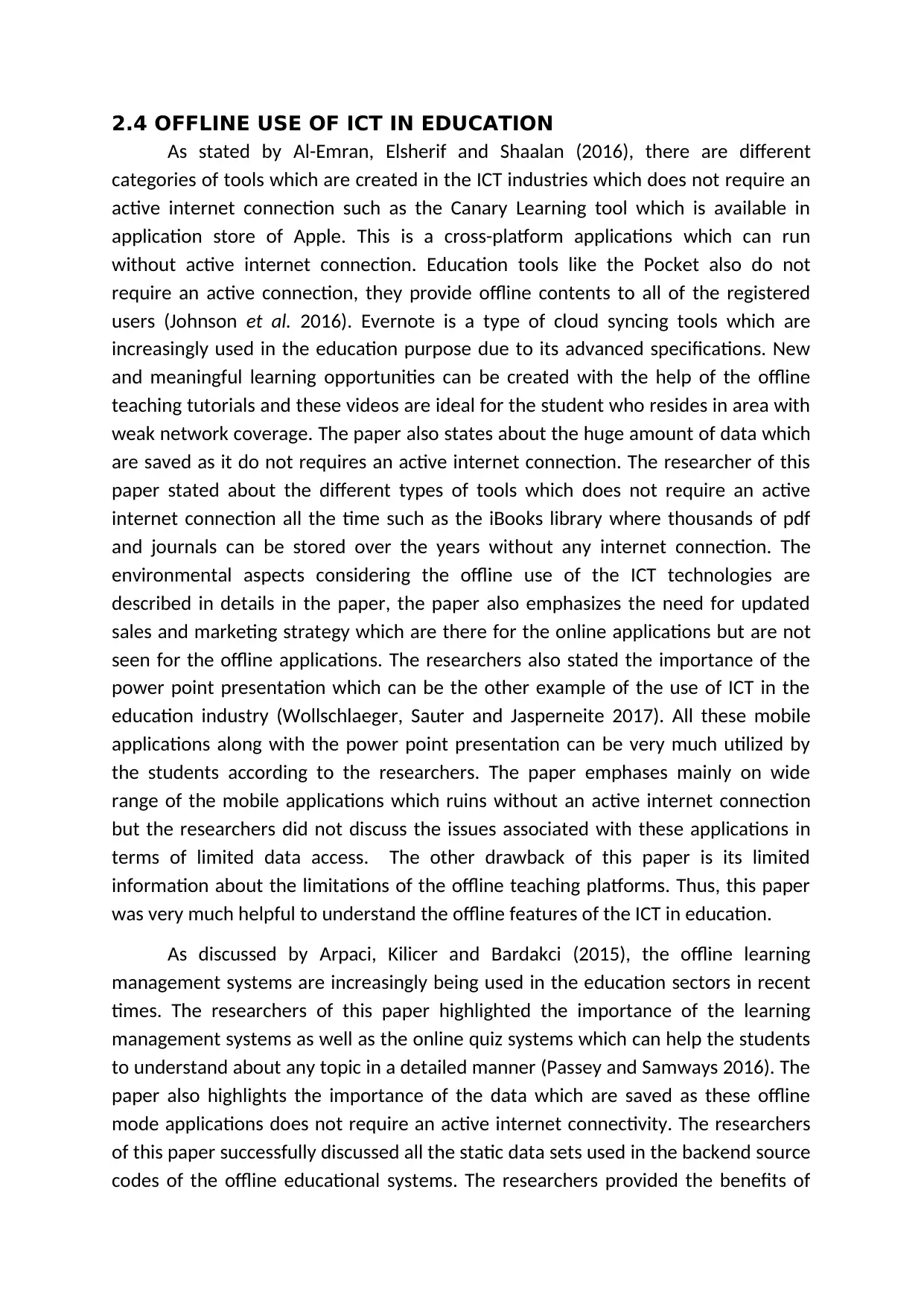
2.4 OFFLINE USE OF ICT IN EDUCATION
As stated by Al-Emran, Elsherif and Shaalan (2016), there are different
categories of tools which are created in the ICT industries which does not require an
active internet connection such as the Canary Learning tool which is available in
application store of Apple. This is a cross-platform applications which can run
without active internet connection. Education tools like the Pocket also do not
require an active connection, they provide offline contents to all of the registered
users (Johnson et al. 2016). Evernote is a type of cloud syncing tools which are
increasingly used in the education purpose due to its advanced specifications. New
and meaningful learning opportunities can be created with the help of the offline
teaching tutorials and these videos are ideal for the student who resides in area with
weak network coverage. The paper also states about the huge amount of data which
are saved as it do not requires an active internet connection. The researcher of this
paper stated about the different types of tools which does not require an active
internet connection all the time such as the iBooks library where thousands of pdf
and journals can be stored over the years without any internet connection. The
environmental aspects considering the offline use of the ICT technologies are
described in details in the paper, the paper also emphasizes the need for updated
sales and marketing strategy which are there for the online applications but are not
seen for the offline applications. The researchers also stated the importance of the
power point presentation which can be the other example of the use of ICT in the
education industry (Wollschlaeger, Sauter and Jasperneite 2017). All these mobile
applications along with the power point presentation can be very much utilized by
the students according to the researchers. The paper emphases mainly on wide
range of the mobile applications which ruins without an active internet connection
but the researchers did not discuss the issues associated with these applications in
terms of limited data access. The other drawback of this paper is its limited
information about the limitations of the offline teaching platforms. Thus, this paper
was very much helpful to understand the offline features of the ICT in education.
As discussed by Arpaci, Kilicer and Bardakci (2015), the offline learning
management systems are increasingly being used in the education sectors in recent
times. The researchers of this paper highlighted the importance of the learning
management systems as well as the online quiz systems which can help the students
to understand about any topic in a detailed manner (Passey and Samways 2016). The
paper also highlights the importance of the data which are saved as these offline
mode applications does not require an active internet connectivity. The researchers
of this paper successfully discussed all the static data sets used in the backend source
codes of the offline educational systems. The researchers provided the benefits of
As stated by Al-Emran, Elsherif and Shaalan (2016), there are different
categories of tools which are created in the ICT industries which does not require an
active internet connection such as the Canary Learning tool which is available in
application store of Apple. This is a cross-platform applications which can run
without active internet connection. Education tools like the Pocket also do not
require an active connection, they provide offline contents to all of the registered
users (Johnson et al. 2016). Evernote is a type of cloud syncing tools which are
increasingly used in the education purpose due to its advanced specifications. New
and meaningful learning opportunities can be created with the help of the offline
teaching tutorials and these videos are ideal for the student who resides in area with
weak network coverage. The paper also states about the huge amount of data which
are saved as it do not requires an active internet connection. The researcher of this
paper stated about the different types of tools which does not require an active
internet connection all the time such as the iBooks library where thousands of pdf
and journals can be stored over the years without any internet connection. The
environmental aspects considering the offline use of the ICT technologies are
described in details in the paper, the paper also emphasizes the need for updated
sales and marketing strategy which are there for the online applications but are not
seen for the offline applications. The researchers also stated the importance of the
power point presentation which can be the other example of the use of ICT in the
education industry (Wollschlaeger, Sauter and Jasperneite 2017). All these mobile
applications along with the power point presentation can be very much utilized by
the students according to the researchers. The paper emphases mainly on wide
range of the mobile applications which ruins without an active internet connection
but the researchers did not discuss the issues associated with these applications in
terms of limited data access. The other drawback of this paper is its limited
information about the limitations of the offline teaching platforms. Thus, this paper
was very much helpful to understand the offline features of the ICT in education.
As discussed by Arpaci, Kilicer and Bardakci (2015), the offline learning
management systems are increasingly being used in the education sectors in recent
times. The researchers of this paper highlighted the importance of the learning
management systems as well as the online quiz systems which can help the students
to understand about any topic in a detailed manner (Passey and Samways 2016). The
paper also highlights the importance of the data which are saved as these offline
mode applications does not require an active internet connectivity. The researchers
of this paper successfully discussed all the static data sets used in the backend source
codes of the offline educational systems. The researchers provided the benefits of
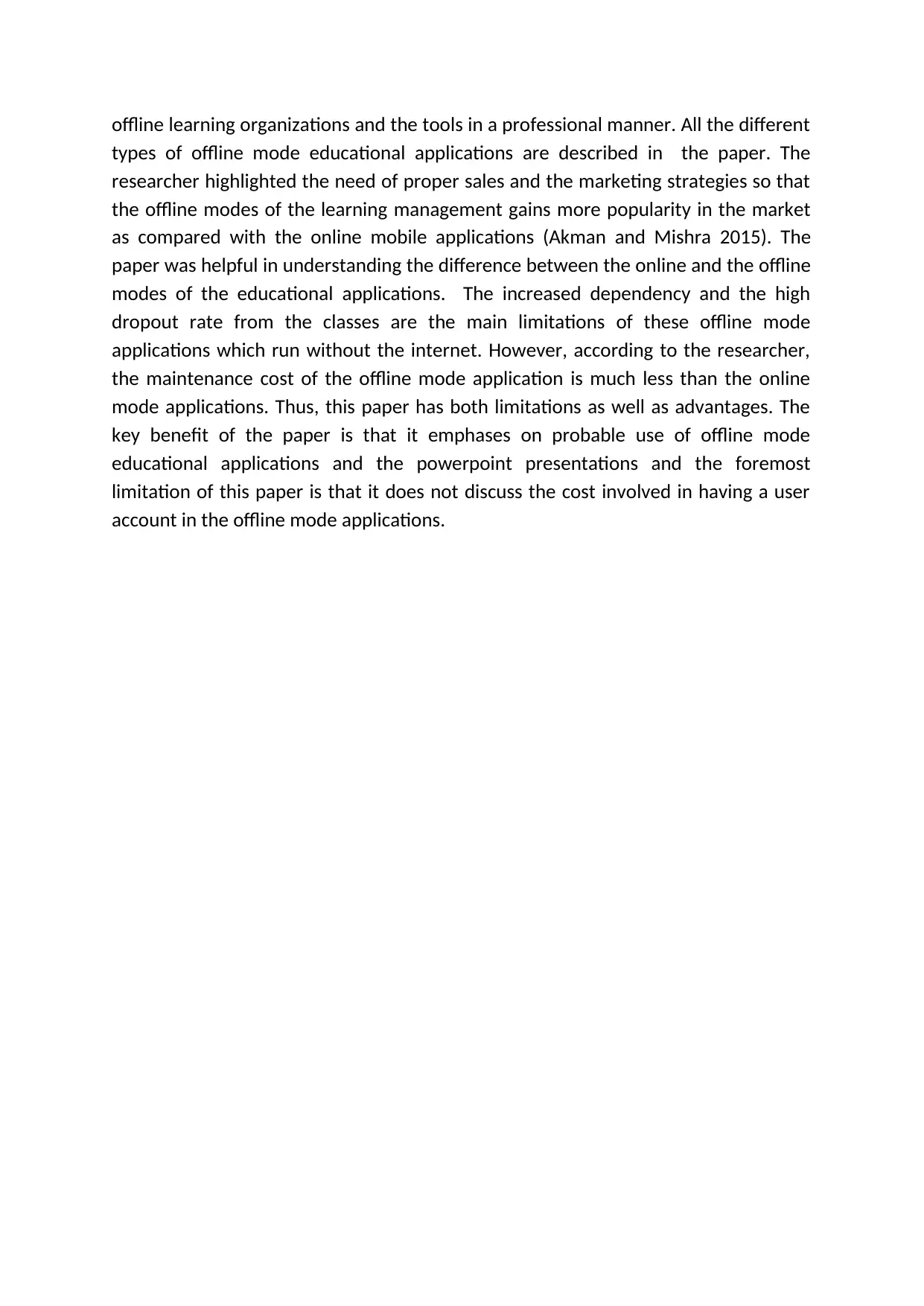
offline learning organizations and the tools in a professional manner. All the different
types of offline mode educational applications are described in the paper. The
researcher highlighted the need of proper sales and the marketing strategies so that
the offline modes of the learning management gains more popularity in the market
as compared with the online mobile applications (Akman and Mishra 2015). The
paper was helpful in understanding the difference between the online and the offline
modes of the educational applications. The increased dependency and the high
dropout rate from the classes are the main limitations of these offline mode
applications which run without the internet. However, according to the researcher,
the maintenance cost of the offline mode application is much less than the online
mode applications. Thus, this paper has both limitations as well as advantages. The
key benefit of the paper is that it emphases on probable use of offline mode
educational applications and the powerpoint presentations and the foremost
limitation of this paper is that it does not discuss the cost involved in having a user
account in the offline mode applications.
types of offline mode educational applications are described in the paper. The
researcher highlighted the need of proper sales and the marketing strategies so that
the offline modes of the learning management gains more popularity in the market
as compared with the online mobile applications (Akman and Mishra 2015). The
paper was helpful in understanding the difference between the online and the offline
modes of the educational applications. The increased dependency and the high
dropout rate from the classes are the main limitations of these offline mode
applications which run without the internet. However, according to the researcher,
the maintenance cost of the offline mode application is much less than the online
mode applications. Thus, this paper has both limitations as well as advantages. The
key benefit of the paper is that it emphases on probable use of offline mode
educational applications and the powerpoint presentations and the foremost
limitation of this paper is that it does not discuss the cost involved in having a user
account in the offline mode applications.
⊘ This is a preview!⊘
Do you want full access?
Subscribe today to unlock all pages.

Trusted by 1+ million students worldwide
1 out of 15
Related Documents
Your All-in-One AI-Powered Toolkit for Academic Success.
+13062052269
info@desklib.com
Available 24*7 on WhatsApp / Email
![[object Object]](/_next/static/media/star-bottom.7253800d.svg)
Unlock your academic potential
Copyright © 2020–2025 A2Z Services. All Rights Reserved. Developed and managed by ZUCOL.




